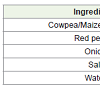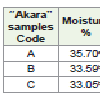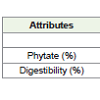Research Article
Proxmate, Phytic acid Content and In-vitro Protein Digestibility of “Akara” Prepared from Cowpea/Maize Flour Blends from Nigeria
Akusu OM and Wordu GO*
Department of food science and technology, Rivers state university of science and technology, Nkpolu - Port Harcourt, Nigeria
Corresponding author: Wordu GO, Department of food science and technology, Rivers state university of science and technology, Nkpolu - Port Harcourt, Nigeria; E-mail: wordugab@yahoo.com
Citation: Akusu OM, Wordu GO. Proximate, Phytic acid Content and In-vitro Protein Digestibility of “Akara” Prepared from Cowpea/Maize Flour Blends 03 from Nigeria. Indian J Nutri. 2017;4(5): 173.
Copyright © 2017 Akusu OM, et al. This is an open access article distributed under the Creative Commons Attribution License, which permits unrestricted use, distribution, and reproduction in any medium, provided the original work is properly cited.
Indian Journal of Nutrition | ISSN: 2395-2326 | Volume: 4, Issue: 5
Submission: 31/08/2017; Accepted: 12/10/2017; Published: 06/11/2017
Abstract
Phytic acid content, in-vitro protein digestibility and proximate properties of “Akora” prepared from cowpea/maize flour blends in the ratio of CM 100:0, CM 70:30 and CM 60:40 were evaluated. The phytic acid content of the “Akara” increased from 4.55% to 6.6% as the level of maize substitution increased from 0% to 40% whereas the in-vitro protein digestibility of the “Akara” decreased from 65.9% to 58.5% as the level of maize substitution increases from 0% to 40%.
Keywords:
“Akara” cowpea/maize flour; In-vitro protein digestibility
Introduction
In the Sub-Sahara region of the tropics, protein deficiency in diets is common and is usually associated with deficiencies in calories leading to epidemic protein malnutrition with its attendant health consequences particularly in children and the elderly; the most vulnerable from the low income groups who constitute the bulk of the population. Low protein intake is attributed to the increasing high cost of animal source and also inadequate utilization of most plant protein sources, but to depend on cereals and legumes which are cheaper than animal products [1].
Cereals are widely cultivated and consumed crops on a global basis and are the major sources of energy and protein in the diets of some people. The same applies to legumes. A combination of cereal and legumes of which akara is made will compensate the limiting amino acid in the plant food, for the populace.
Plant foods have been reported to contain a large number of naturally occurring toxic components that have diverse effects on man [2]. Legumes contain anti-nutritional factors which hinder the efficient utilization, absorption or digestibility of nutrients. The digestibility of proteins is a crucial factor in protein evaluation.
While amino acids profile is important in evaluating the nutritional quality of a protein, digestibility is most important determinant of the quality of a protein source [3]. Since the digestibility of protein is a crucial factor in protein evaluation. This study evaluated the in-vitro protein digestibility and phytate content of akara preparation from cowpea/maize flour blends.
Materials and Methods
Materials
Cowpea (Vigna unguiculata) and white maize (Zea mays) are purchased from a local market in Port Harcourt. All reagent used were of analytical grade. Pepsin and pancreatic enzymes were obtained from sigma chemical Co. (St. Louis MO, USA).
Methods
Preparation of flour samples: The procedure described by Odum et al. was used for the preparation of the cowpea and maize flour [4]. Whole-seed samples (1 kg each of cowpea and maize were sorted, cleared and separately soaked at room temperature (28 ± 1°C) in tap water at a bean to grain ration of 1:5 for 12 hours. Manually dehulled presoaked cowpea and maize grains separately autoclaved at 121°C, 1.05 kg CM2 for 15 minutes were oven dried at 60°C for 24 hours in a hot air fan oven (model QUB), 305010G Gallenkamp, UK).
These were then ground separately using a Laboratory Mil (Numez Pep Grinding Mill, India and sifted through a 300 pm sieve (model BS 410, Endcotts Ltd, UK) obtain cowpea and maize flour.
Preparation of flour blends: The preparation of the flour blends involves replacement of part of the cowpea flour (CF) with 0% (CM 100:0), 30% (CM 70:30) and 40% (CM 60:40) Maize Flour (MF) by gradual mixing of MF into CF in a mixing bowl using a wooden spatula.
Preparation of akara: A modified receipt of Mc waters, Ngoddy et al. and the procedures outlined by Giami et al. were used for the akara preparation as shown in Table 1 [5,6].
Two hundred grams of the flour blends and the control (A-C) were each mixed with 170 ml of warm water at 45°C in a mixing bowl using a wooden spatula to form a smooth paste. The onions and pepper were ground together using a Phillip electric blend (model NR 2817/A, Mexico); salt was added to the paste and whipped for 2 minutes in a Kenwood blender (Model A 907d) at a speed of 500 rpm to incorporate air.
Portions (l2 ± 1 g) of the whipped pastes were scoped and fried in 1 liter of refined vegetable oil (King’s Brand, bevon Ind. Singapore) at 185-190°C for 4 minutes to yield akara balls.
The fried akara balls were cooled and oven dried at 50°C and used for proximate, phytic acid determination and in-vitro protein digestibility.
Proximate analysis of akara samples
Moisture (method 14.004), total ash (method 14.006), crude fiber (method 7.070), ether extract (method 7.062) and crude protein (method 2.057) were determined according to AOAC procedures. The factors N x 6.25 was used for conversion of nitrogen to crude protein. Carbohydrate content was calculated by difference. Energy values of akara were calculated by applying the “At water” factors of 4.1, 9.1 and 3.75 approximately for each grain of protein, fat and carbohydrates respectively.
Phytic acid determination
A combination of two methods was used for the phytic acid determination using 11 ± 0.01 g of akara and moin-moin samples. The extraction and precitation of phytic acid were done according to the method of Wheeker and Ferrel; Iron in the precipitate was measured by procedure 14.013 of the AOAC A 4:6 Fe/P molecular ratio was used to calculate phytic acid content as expressed as mg phytic acid per 100g of akara or moin-moin [7,8].
In-vitro Protein Digestibility Determination
In-vitro protein digestibility of akara samples was determined by the procedure outlined by Sanders et al. as modified by Monsor and Yusuf to assess protein digestibility (in-vitro) of akara and moin-moin using double enzyme porcine pepsin powder (p 7000) and pancreatin (1500) obtained from sigma chemical Co. (St Louis, MO, USA) [9,10].
The nitrogen content of the samples was determined by Kjeldah method [8]. Protein digestibility was calculated using the following equation

Phytic acid determination
Phytic acid was analyzed by the method of Wheeler and Ferrel using 1 ± 0.01 g of test akara samples; the iron in the precipitate was measured using the procedure 14.013 in AOAC A 4:6 Feb/p molecular ratio was used to calculate phytic acid content (%) [7,8].
In-vitro protein digestibility determination
In-vitro protein digestibility of akara samples was determined by the method of Sanders et al. as modified by Monsor and Yusuf, using double enzymes of pepsin and pancretin (P1500) [9,10]. The enzymes porcine pepsin powder (P7000) and pancretin (P1500) were obtained from sigma chemical Co (St. Louis M.O. U.S.A). The nitrogen content of the test akara sample (200, 0.1 mg) and of the indigestible residue were determined by the kjeldahl method AOAC.
Protein digestibility was calculated as follows

Statistical analysis
All experimental and analysis were carried out in triplicates and the means of variance (ANOVA) using a general linear model. Ducan multiple range tests were used to separate means where significant existed.
Result and Discussion
Proximate composition
The data on the proximate composition of “akara” prepared from cowpea/maize flour blends is presented in Table 2. In the “akara” samples, the crude protein decreased from 21% to 19% as the level of maize substitution increased from 0% to 40%; the carbohydrate increased from 19% to 27% as the level of maize substitution increased from 0 to 40% for “akara”.
It should be noted that “akara” prepared from sample C(60:40) was considered to be nutritious since the consumption of about l00 g of this sample can provide for more than half of recommended daily requirements of protein (25-30 g/day) and about 1/6 of the required energy (1790-2500) Kcal/day) as recommended by FAO/ WHO for children aged between 5 and 19 years. Therefore the protein and energy content of akara prepared from this flour blend would be useful as food supplements for the children of protein energy malnutrition in developing countries [3].
In-vitro Protein Digestibility and Phytic Content of “Akara” Samples
The in-vitro protein digestibility and phytic acid content of akara prepared from cowpea and maize flour blends as presented in Table 3 shows that as the level of maize substitution increased from 0% to 40% in the akara samples, the phytic acid content also increased from 4.55% to 6.6% while the in-vitro protein digestibility decreased from 65.9 to 58.5% compared with casein which has 90% digestibility.
Liener and other workers have reported that phytic acid as an antinutritional factor in plant food reduces the digestibility, bioavailability and nutritional quality of plant foods. Several workers have reported improvement in in-vitro protein digestibility of oil seeds, legumes and cereals by germination, fermentation, soaking and cooking [10-13]. These workers proposed that during germination, fermentation or soaking, the storage proteins of seeds and grains undergo partial hydrolysis by endogenous proteases to soluble proteins and free amino acids which are more susceptible to pepsin attack. They further stated that improvement in protein digestibility appears to be that the insoluble proteins (prolamine and glutelin) undergo structural changes which makes them more accessible to pepsin attach rather than being broken down into smaller sub-units. However, there was no significant difference (p>0.5) in the digestibility of all cowpea akara and that prepared from 70:30 cowpea: maize flour blends.
Thus the digestibility observed in this study can be improved upon if the cowpea and maize soaking period is increased further so that the benefit of blending cowpea with maize in akara and moin-moin preparation and consumption can be relished.
It should be noted that in recent tumes in Nigeria, the traditional method of preparation of cowpea paste for akara and moin-moin no longer involves soaking for up to even 30 minutes, as it has been “so called modermized” way to milling the dry cowpea, winnowing, soaking and dehulling just for less than 10 minutes before grinding into paste. This method is likely to reduce the digestibility of akara and moin-moin prepared from such cowpea significantly. It is therefore advisable to soak the cowpea and the maize for up to or more than 12 hours in other to improve the digestibility.
Conclusion
This study reveals that “akara” prepared from cowpea/maize flour blend with 40% level of maize substitution had good protein and energy values. As the level of maize substitution increased from 10% to 40% in the akara sample, the phytic acid content increases while the in-vitro protein digestibility decreases. There by decreasing the nutritive value of “akara” prepared from such cowpea/maize flour blends.
References
- Osagie AU, Eka OU (1998) Nutritional quality of plant foods. J Agric Food Chem 49: 32-52.
- Achinewhu SC (1987) Protein quality evaluation of weaning food mixture from indigenous fermented foods. Nigeria J Nutr Sci 8: 23-33.
- FAQ/WHO (1973) Energy and protein requirements. Food and Agriculture organization. pp. 118.
- Odum PK, Adamson LA, Moragne L, Edwards CH (1981) A weaning food from locally grown grams in Nigeria. Formulation and organoleptic evaluation. Nutritional reports international 23: 1005-1019.
- Mc Watters KH (1983) Composition, physical and sensory characteristics of Akara processed from cowpea paste and Nigerian cowpea flour. J Cereal Chem 60: 333-336.
- Ngoddy PO, Enwere NJ, Onuorah V1 (1986) Cowpea flour performance in akara and moin-moin preparation. Trop Sci 26: 101-119.
- Wheeler EL, Ferrel RE (1971) A method for phytic acid determination m wheat and wheat fractions. Cereal Chemistry 48: 312-320.
- AOAC (2007) Official method of analysis, (18th edn). Washington D.C Association of Official Analytical chemists, Gaithersburg.
- Sanders RM, Connor MA, Booth AN, Bickhoff EM, Kohler GO (1973) Measurement of digestibility of alfalfa protein concentrates by in-vivo and in-vitro methods. J Nutr 103: 530-535.
- Monsor MA, Sc Yusuf HK (2002) In-vitro protein digestibility of lathyrus pea (Lathyrus sativus) lentil (Lens culinaris) and chickpea (Ccicer arietinum). Int J Food Sci Technol 37: 97-99.
- Akpapunam MA, Achinewhu SC (1985) Effect of comparing germination and fermentation on the chemical composition of Nigerian cowpea (Vigna unguiculara). Plant Foods Hum Nutr 35: 353-3 58.
- Abiodun F, Elegbede A (1998) Nutritional quality of plant proteins. Food Chem Toxic 20: 53-85.
- Taylor J, Taylor JR (2002) Alleviation of the adverse effect of cooking on sorghum protein digestibility through fermentation in traditional African porridges. Int J Food Sci Techno 37: 129-137.



